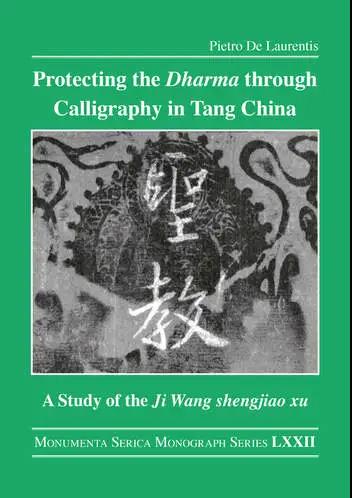作者:毕罗 发布时间:2021-12-04 来源:复旦大学中华文明国际研究中心+收藏本文

简介
本书收入德国华裔学志研究所《华裔学志丛书》系列中,这是一部既受传统汉学文史熏陶,又有跨学科旨趣的书法文化史著作。本书将中国书法史上最早、最优秀的集字石刻《集王圣教序》碑(立于673年1月1日,唐高宗咸亨三年十二月八日)作为核心论题,介绍了中古中国佛教与书法的关系,包括长安佛教团人为了护教,如何利用中国传统艺术之一的书法等情况。此碑记载了两位唐朝皇帝——唐太宗(599—649)和唐高宗(628—683)——为表彰僧人玄奘(卒于664年)而作的文章和《心经》经文,碑文的书法集自王羲之(303—361)的行书作品。因此,它是一个集佛教权威、政治权力和书法艺术魅力于一体的佛教碑刻。本书解析了此设立的多重背景,旨在突出书法在中古中国佛教传播和护法中的特殊作用。
本书搜集和整理了大量的历史文献和考古实物,对《集王圣教序》的立碑背景、碑刻外观以及雕刻工艺和书法特征做了详尽的分析。除此之外,在重构历史面貌时以问题意识和探索精神,挑战了传统鉴赏界关于此碑的许多观点,并且重新解读了太宗与玄奘之间的关系的真面目。
此书三分之一内容为一览表与附录,说明中国古代研究的基础是对庞大资料的宏观掌握和处理。通过宗教、政治和书法在唐朝初期的错综复杂的关系的梳理和探讨,《以书护法》表明书法史研究的前提条件是将“书法现象”放在更广阔的历史文化环境中才能做出有可持续性的研究成果。只有将书法作为汉学领域极有学术地位的话,才能充分理解中国古代灿烂文明的魅力与世界意义。
目录
导论
中古中国的佛教和书法
王羲之的书法和行书
一.《集王圣教序》及其文本
二.《集王圣教序》的立碑背景
三.《集王圣教序》立碑和安放地点的历史
四.《集王圣教序》的集字过程
五.《集王圣教序》碑的雕刻工艺过程
六.《集王圣教序》碑的外观和书法特征
总结
附录1:《集王圣教序》录文及翻译
附录2:集王碑刻综览
一览表
1)《大唐开元释教广品历章》中记载带有太宗《序》和高宗《记》的玄奘译经写本
2)敦煌遗书载有太宗《序》和高宗《记》一览表
3)唐代皇帝为佛经译文撰写的序文表
4)弘福寺寺僧一览表
5)王羲之现存行书作品一览表
6)《集王圣教序》逐字一览表
7)《集王圣教序》与《兰亭序》相同字一览表
8)《集王圣教序》与王羲之现存其他作品相同字一览表
图版
三井纪念美术馆藏《集王圣教序》“刘铁云本”(1-36页)
参考文献
书法术语词汇表
总索引
《华裔学志丛书》:
http://www.monumenta-serica.de/monumenta-serica/publications/monographs/Catalog/Vols-LXX-LXXIV.php
Routledge:
https://www.routledge.com/Protecting-the-Dharma-through-Calligraphy-in-Tang-China-A-Study-of-the/Laurentis/p/book/9781032136936
Book Description
This is a study of the earliest and finest collated inscription in the history of Chinese calligraphy, the Ji Wang shengjiao xu 集王聖教序 (Preface to the Sacred Teaching Scriptures Translated by Xuanzang in Wang Xizhi’s Collated Characters), which was erected on January 1, 673. The stele records the two texts written by the Tang emperors Taizong (599–649) and Gaozong (628–683) in honor of the monk Xuanzang (d. 664) and the Buddhist scripture Xin jing (Heart Sutra), collated in the semi-cursive characters of the great master of Chinese calligraphy, Wang Xizhi (303–361). It is thus a Buddhist inscription that combines Buddhist authority, political power, and artistic charm in one single monument. The present book reconstructs the multifaceted context in which the stele was devised, aiming at highlighting the specific role calligraphy played in the propagation and protection of Buddhism in medieval China.
Table of Contents
INTRODUCTION
CHAPTER ONE Buddhism and Calligraphy in Medieval China
CHAPTER TWO Wang Xizhi’s Calligraphy and the Semi-cursive Script (Xingshu 行書)
CHAPTER THREE The Ji Wang shengjiao xu and Its Texts
CHAPTER FOUR The Context of the Erection of the Ji Wang shengjiao xu
CHAPTER FIVE A History of the Location of the Ji Wang shengjiao xu
CHAPTER SIX The Collation of Wang Xizhi’s Characters for the Ji Wang shengjiao xu
CHAPTER SEVEN The Carving of the Ji Wang shengjiao xu
CHAPTER EIGHT The Shape and the Calligraphy of the Ji Wang shengjiao xu
CONCLUSION
APPENDICES
Appendix I: Transcription and Translation of the Ji Wang shengjiao xu
Appendix II: A Survey of Collated Inscriptions in Wang Xizhi’s Characters
TABLES
FACSIMILE
Complete Reproduction of Mitsui Ji Wang 1 (Folios 1-36)
BIBLIOGRAPHY, GLOSSARY, AND INDEX
Bibliography
Glossary of Calligraphic Terms
General Index
Author's Biography
Pietro De Laurentis was born in southern Italy and studied Sinology at the University of Naples “L’Orientale,” where he received his Ph.D. in East Asian Studies in 2007. He was trained in Chinese philology and Chinese calligraphy, theoretical and practical, in Hangzhou, Tianjin, and Shanghai. From 2010 to 2016 he was Research Fellow at the University of Naples “L’Orientale,” where he taught Literary Chinese and Modern Chinese. He is currently visiting professor at the Guangzhou Academy of Fine Arts.
Pietro De Laurentis stayed at ICSCC as a visiting scholar from March to September 2017.